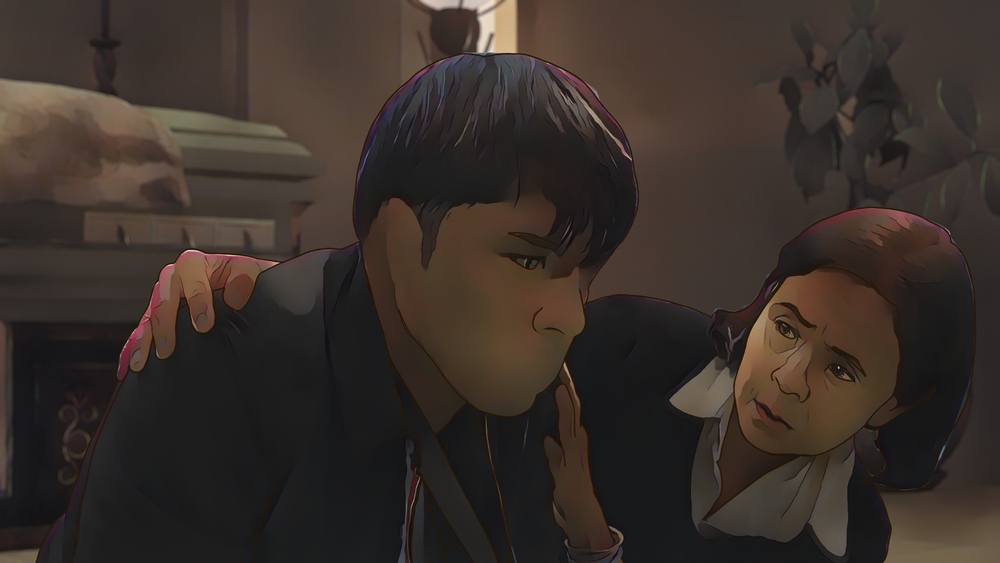 Carlo Aquino and Dolly de Leon.
Carlo Aquino and Dolly de Leon.
Carl Joseph Papa's Oscar submission The Missing (original title: Iti Mapukpukaw) centers on a mouthless young man whose life is rocked when a familiar alien returns to his life. In telling this deeply personal story using animation, Papa examines the long-term effects of childhood trauma on people and how far kindness could go in helping them in reclaiming their voice. The Missing is the Philippines' official submission for Best International Feature Film at the 96th Academy Awards, becoming the country's first animated feature film to represent the country (out of 33 submissions). Out of the eight countries that submitted for the category's first competitive year in 1956, only the Philippines is yet to be nominated.
In this in-depth discussion, writer-director Carl Joseph Papa and actor Gio Gahol tackle the taboo topic of childhood sexual abuse in the country, pulling off the feat of shooting the film within four days, the artists that inspired them in their craft, and working with BAFTA nominee Dolly de Leon (Triangle of Sadness)...
[This interview has been edited for clarity.]
[CW: Discussions of childhood trauma and sexual abuse]
Juan Carlos: Let's just start with something light: how did you find out that the film was going to be the official submission?
Carl: The Film Academy of the Philippines did an open call for it [for] any film that would want to be submitted or can do a campaign. Then we submitted it. We haven't gotten a message from them for months. And then I just found out that they were deliberating. The morning after seeing that post on Twitter, we got an email saying that we were the one selected. After that, I messaged Gio saying that "yeah, we got in".
JC: Gio, was it also the first time that you found out?
Gio: Only through Carl. And then, how did I feel? The feeling was different from finding out from Carl and when they actually made the announcement. I felt it more when Carl told me. It was more exciting that I knew something that the rest of the country didn't know yet. But it was special because I thought that the wins that we got from Cinemalaya [Philippine Independent Film Festival] was already the cherry on top of the experience of being a part of this film. But first of all, being considered to be the official entry and then becoming the official entry of the country to the Academy Awards, it's just out of this world, I think.
JC: It's exciting to see that this is the first animated feature that we submitted to the Oscars. This is your third animated feature and your fourth feature in general. Timing is everything in making films. Specific time in your career, time in the Philippines, time in cinema. I would like to ask a two part question: why this story and why are you telling it now?
C: The story came to me around 2018-2019. It was based on personal experience. When I wrote it down, I just wanted to write something to cope with what happened because the guy who did sexual advances to me when I was young was already dead. That was my starting point for writing the film. But at first, it started from a place of anger because there's nothing I could do. If I look back on the earlier drafts of the script, it's a different story and a different version of what you have seen. But sitting down and reading it again and again and doing interviews of other victims of sexual abuse and rape, I guess it kinda mellowed me down and tamed the story a bit. The goal of the film shifted from just being a coping mechanism to becoming more of encouraging people to reclaim their voice or finding their truths and telling their stories.
Actually, I pitched this story as early as 2019. But during the pandemic, I was able to sit down and look through the script and then did a lot of revisions on it. And then it came to a point - around late 2021 - that I knew the story was done. There was nothing I could add more to it other than if I ask people to read it and then comment on it. But for me, it was already done and ready to be shown. Because whenever I make films, I try to put myself in the shoes of other people. Like in Manang Biring, I want to get into the shoes of my mom. And then for Paglisan (The Leaving), it was for my grandparents. For this one, I'm just putting on my own shoes. This is my story and this is a story of other victims. I think that this is high time to tell this kind of story in this kind of way. It's not entirely new, but here in the Philippines, it's quite a taboo topic. It just so happens that I'm ready to tell this now, I'm ready to tell the world what happened and encourage people to talk.
Gio, I wanna pivot quite a bit. 2023, quite a year. Aside from this film that received critical acclaim, you also got back to theater with Laro and PETA's Walang Aray which I love so much. So how did this story find its way to you? Or was it the other way around?
G: This is based on Carl's account on how he found me. I think the first time he saw me was in Sila-Sila (The Same People) back in 2019. That's when he really paid attention when he saw me.
C: Because you were great in that movie.
G: So that was in 2019. And then in 2022, in Cinemalaya last year, I was featured in one of the entries which was Bula sa Langit (Trigger). And he actually attended the gala screening of our film. He even had his photo taken with me after the screening. And then I think it was a week after that someone messaged me from Project 8 (production company), asking if I was interested to be part of a Cinemalaya entry for the following year. And then I didn't know Carl yet. He didn't even introduce himself when he asked to take a photo with me. But when we finally touched base and he was gonna send me the script to read through it, he sent a photo - that photo that he took when he watched Bula sa Langit. It's like, "Oh, okay. You watched, thank you."
I don't know what it is about me and these scripts that land on my lap that have to do with a lot of mental health issues. I guess you attract what you are. Moment of vulnerability here: I also struggle with my personal mental health struggles. And I think this is the universe basically telling me that I can use it, the fact that I'm well aware of these specific struggles. But I think it also helps me embrace my own issues, that it is a part of my reality. So from Bula sa Langit which dealt with PTSD to this one which deals with dissociative [identity] disorder caused by childhood trauma.
Of course, in The Missing, I'm on the flip side. I'm not the one who has the childhood trauma. It was interesting to be on that side of the story this time around. I am a storyteller, whether in theater or in film, so I like being able to picture things in my head before jumping into it. So just reading the script, I don't know if this is verbatim but I told Carl that the story was just really visually on-point. There is no other way to tell this story except how he wrote it. There was so much strength in the language that was being used, but the imagery was so rich that it doesn't need to be complicated anyway. It definitely cuts across so many levels of understanding.
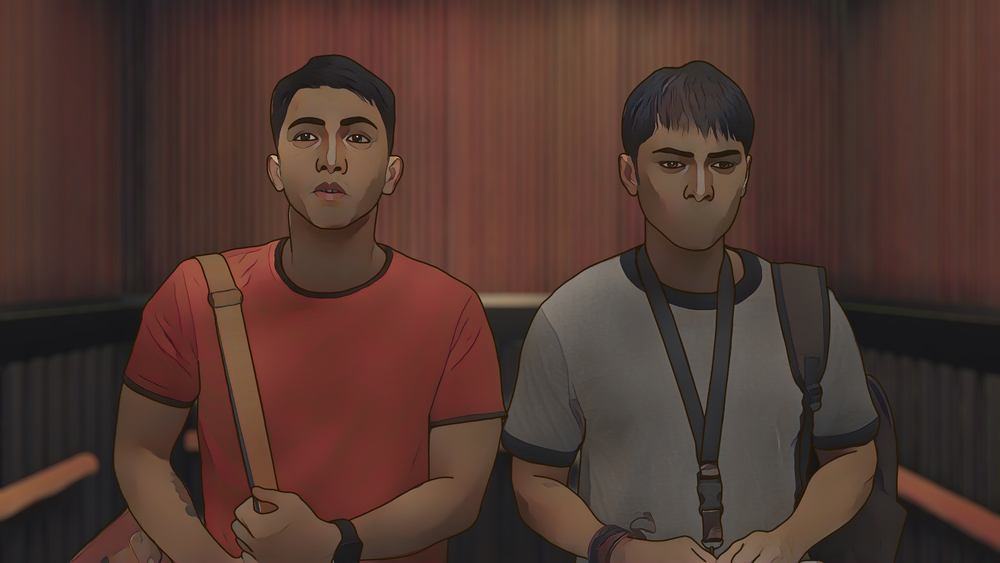 Gio Gahol and Carlo Aquino.
Gio Gahol and Carlo Aquino.
JC: Did it present a different challenge for you as an actor knowing that this would be an animated film?
G: Absolutely. It was challenging even before we started shooting. You know how in theater, you bounce energy off one person to the next or or just generally the body language, there's a density on how you hear people talk to you. And I wasn't gonna have that in this film. And I've never done an animated film and all I know is Carl said it would be done in green screen. I've never experienced that. Again, as a visual performer, it's hard not having visual cues like where you are, how far away like a certain part of this world is from where you are or how near.
So that was very challenging, but I think I just held on tight to Carlo Aquino (lead actor). Not literally, but the important part anyway in the story is the connection between Carlo and Eric. And thankfully, Carlo Aquino is a very present actor even though he couldn't talk. Just looking deeply into his eyes already provided more than enough information for me to get through the scene without fumbling because of the lack of a lot of things that should have been there.
JC: Carl, given that you have these three great actors and with how emotional and heavy the story is, was it an easy decision for you to tell this story using animation? And specifically, having two styles - rotoscoping and hand-drawn animation?
C: Yes, actually. When I wrote the film, I knew from the get-go that it's going to be [an] animation and it was going to be [rotoscoping]. One thing about rotoscoping is that you sort of confuse whether things are real or not. That compliments the mental state of Eric, the protagonist in the film. I wanted a visual style that would compliment the film, not just visuals but also audio. And for the 2-D hand drawn animation, we presented it in a way that it feels like it's very childish and nostalgic. We wanted to evoke a feeling like it's a memory of a kid or someone or a certain part of your memory that is stuck in your childhood.
JC: With that being said, it unfolds in a way that I didn't know exactly what I was gonna get. But once you revealed the actual nature of the story and what's going on, it didn't feel like a gotcha moment. And I think there's a thin line between having an emotionally powerful reveal and a twist that would verge on emotional exploitation. How did you map things out so that you were bringing in these details?
C: In terms of the narrative, I just wanted to make sure that it was gradually being revealed. When you're trying to remember something from your childhood, or something in the past that's kind of buried, you don't remember things from the get-go, how I remember everything from what happened. But it's more of whatever is happening right now, it triggers you to remember things from the past. That's what I did.
There is a very long flashback sequence towards the middle of the film where a young Eric goes to the alien plant. I put that there because I knew that was the moment where Eric was at his most vulnerable. And then I reveal more as I go along and then I pull back. Actually, we didn't use the term 'sexual abuse' or 'rape'. We didn't let people see what actually happened to Eric, but it's more implied. It's just a balance of pushing and pulling of what to show and what to tell the audience
JC: Because as a storyteller, it is a balance to be had in making sure that your vision makes sense.
C: Actually, can I share something?
JC: Go ahead.
C: Not just with the story and with the style. I think you will notice in the 2-D hand-draw animation, it also plays around whether things are more jittery. If it's more jittery, it's more fake. Those are my visual cues. Also, for the music and the sound, the music starts off playful, and then as the story progresses, it feels darker and more somber. We wanted to make it feel like, especially for those "funny" scenes, we wanted to make it feel like it is funny, but you're gonna question whether it's really funny or not. Everything has to progress. Not only the story, visuals, but also sound and music. Even the acting. Carlo Aquino gets progressively agitated as the story progresses.
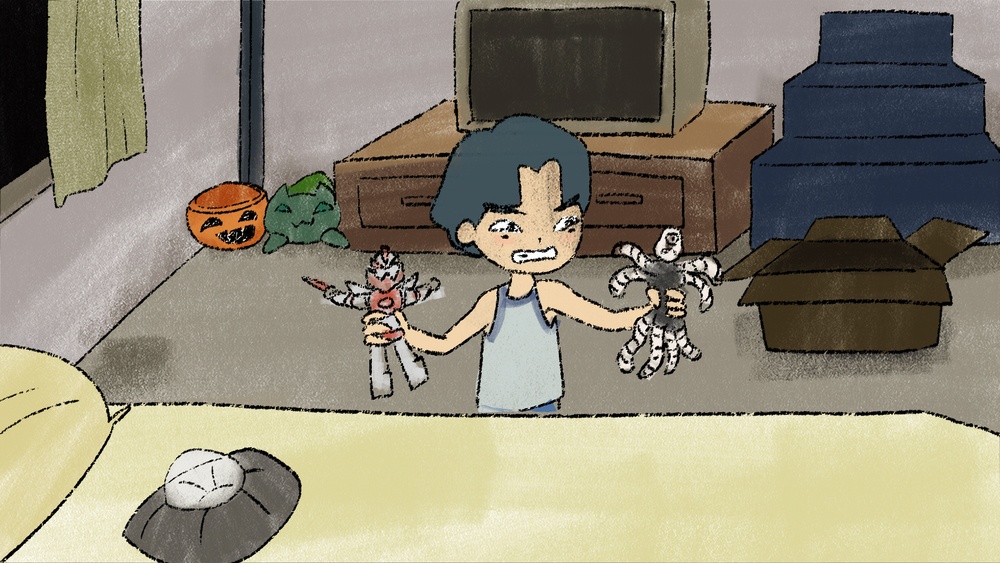 A scene from the film.
A scene from the film.
JC: I did love that. Because on the second watch, you see the small details that hit you hard. There's an identification that's quite horrifying. You already mentioned Carlo Aquino who I think gives one of his best performances and he doesn't even have a full face to do that.
Gio, you are kind of the spectator, but you are not just watching by the wayside. You establish a genuine connection with [Eric]. What is the challenge of having that character who does not have the main arc of the film, but yet is so substantial in making us feel or even empathize with the main character?
G: In my 36 years of existence, I've learned so much about extending kindness whenever possible. Of course, with kindness comes patience, genuine concern, and care for other people. This person, Eric, is clearly in need of help. It saddens me that we're growing up in a world where we question moments of helplessness. That unless it's something we can understand, we have to justify why people feel helpless before we even decide to help. That's one of the beautiful experiences that I have with this film. It was an exercise of humanity.
A lot of people would say that Carlo or Rosalinda's mom are unrealistic, but are they? I mean, maybe it has become realistic as humanity has "progressed", but isn't that how we really should be? That should be a reality. We don't have to easily give up on things just because we don't understand them. We all have different realities. Eric's reality is something that Carlo could not perceive first-hand, but his feeling of helplessness is real. I could identify that. So even if Carlo couldn't see what was causing distress to Eric, he should help however way possible. And that's really genuine kindness.
This isn't like humble brag, I don't wanna say that. When people say "oh my gosh, you really portrayed such a caring character successfully" and in my head, was it just a portrayal? My friends who have seen the film who really know who I am, they said "you know, the things that Carlo was doing, I could totally picture you doing that in real life". There is just so much heart in this film that isn't pretentious. There's hardly any pretension in it. And I'm not just talking about how we just want to give a voice to the voiceless. We're also trying to reframe the behavior of those who have the voice.
Eric's character has inabilities. Carlo and Rosalinda are able. So what are those people who are able, what can they do? I don't feel like it was that big of a challenge for me because it's just one of the things that I'm trying to emulate in my life. Just to be really more human and be kinder, be more helpful.
JC: It comes across in the film. There is already this strong connection that is evident in these two characters. When I was watching [the film], I was thinking either this is such a personal story or the storyteller is just so empathetic to these characters that even when Eric is experiencing trauma, it never really felt like he was being subjected by the film to so much pain. It felt like the film was always on his side.
And speaking of Rosalinda, for a lot of non-Filipino fans, they have been waiting for what Dolly de Leon is going to do post-Best Picture nominee Triangle of Sadness. She's given us four films just this year and this is the one that brought her back to awards conversation because this film is being submitted to the Oscars. She's back in the [awards] season. How did she come into this project? Was it before Triangle of Sadness or after?
C: After. Actually, I met her right after Cannes when she got home. There was no buzz yet, but I talked to her. Because I saw Folklore, the episode with Erik Matti. She was amazing in that episode. We talked and she was the first one to do the dubbing because she was also part of the flashbacks. She came after Triangle of Sadness but before A Very Good Girl (another de Leon film this year).
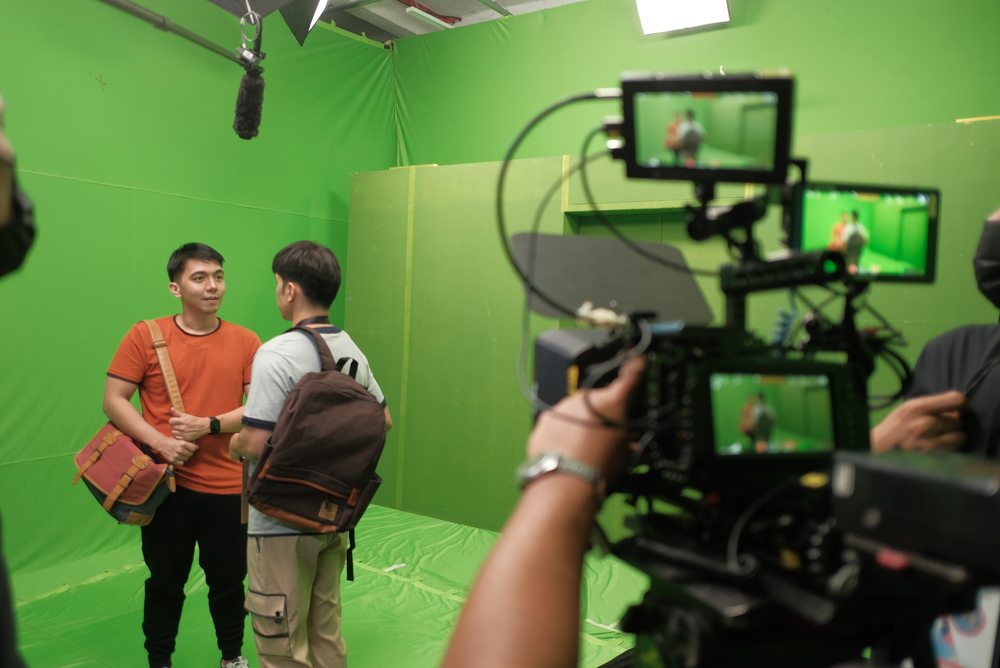 Gio Gahol and Carlo Aquino on set.
Gio Gahol and Carlo Aquino on set.
JC: When was this film filmed?
C: November 2022.
JC: Around the release of Triangle of Sadness in the US. And this is also a supporting role. She's like the burst of joy in this film, but she's not a disruption to the tone. It's not funny-funny, it's more heartwarmingly whimsical. How did you make sure that, with these performances are kind of in different wavelengths, but somehow, when they're together on the screen, there's just magic. How did you make it work?
C: Probably because I grew up with these kind of characters in my family. Rosalinda is patterned after my mom. She's kind of like that. She jokes a lot of the time, but her jokes are her way of showing that she cares, oddly. But I know in my head that since I know these characters and I've met them, I know that if I'll be in one room with these kinds of characters, it will be a riot.
I think that's my motivation when I was doing the characterization. I was thinking of real people and drawing influences from them and thinking if this kind of characteristic from this character would gel with other characters. Actually, one of the reasons why we talked to Gio to be part of the project was I know [he] would bring a certain level of warmth to the character of Carlo which he did beautifully.
JC: And I completely agree that there is a warmth that is visceral. Sometimes, you feel when a film is phoning it in in terms of making something heartwarming. This one is not the case. And this one, even if it goes into darker territories, you feel the love that the characters have for each other.
Also, one thing that strikes me is that a lot of the film is also told in Ilocano (language in Northern Philippines). Most of the mainstream filmmaking in the Philippines is located in Manila which means most of the filmmaking is done in Tagalog. Were there any resistance for you to have extensive use of Ilocano?
C: Actually, no. There was a resistance with the title because it's hard to pronounce. But it being partly in Ilocano, there was no resistance. When I wrote it, I wrote that a part of it is going to be in Ilocos and there are going to be Ilocano characters.
JC: And this was only done in four days, right?
C: We shot in four days.
JC: How's the experience of making this film in four days?
C: It was hard because we didn't have a lot of time, but that was the only time that the actors were all there. That's why we picked those days. If we pick a later date, then we will be more delayed. But those four days, it was meaty. We were doing one sequence after another and luckily, Alwyn Uytingco (assistant director) planned everything smoothly. So I guess there weren't many problems.
It's just tiring. But I feel tired after, not during the shoot. Actually, I only slept like five hours at the maximum per day. But I was ecstatic all the time. Every time I step on the set, whenever we are rolling, I am always on the set, I don't look that much on the monitor. I want to see the actors' acting. I want to see it first-hand rather than on the screen. It was a fun experience. I hope it was the same for Gio. [laughs]
JC: Gio, can you chime in on that question?
G: Of course, it was! I'm surprised you didn't bring up the dancing on-set. Every time we get asked about the shooting process [was], Carl would always bring it up. I think that's my process whenever I'm on set. I can't be idle so yes, we were shooting scene after scene, but while waiting for setup, I try to still be on my toes. For me, it was a very fun set filled with a lot of fun-loving people. So in between takes, we would be singing or we would be dancing.
I think it was also a conscious effort to do that since we all knew the themes of the film were pretty dark. The topic was pretty dark so [we] counter that with some lightness off-camera so we don't fall into the deepest, darkest abyss as we were going down the line shooting the sequences. I was shocked that they only needed me for ten days and even more shocked when I found out [that] we were only shooting for four days. I was lucky that Carlo Aquino and Ms. Dolly were available during the four days that we had because I was only there for the first two days because I had to fly out the day after the second day. And I think Ms. Dolly had just flown in from the US.
It was just a serendipitous moment where "oh my gosh, there is actually a common time frame that these three people are available" so fortunately, my schedule fit perfectly into that time frame. And it was my first time working with Carl so I wasn't sure how he was gonna be on set, but Carl and Alwyn were very hands-on. All the things that I was afraid I wouldn't understand how to do when acting for an animated film, they were there. They were ready to answer any questions and to explain exactly how things should be done. Everything was done smoothly and we didn't even shoot for more than twelve hours a day.
C: We didn't.
G: That was good.
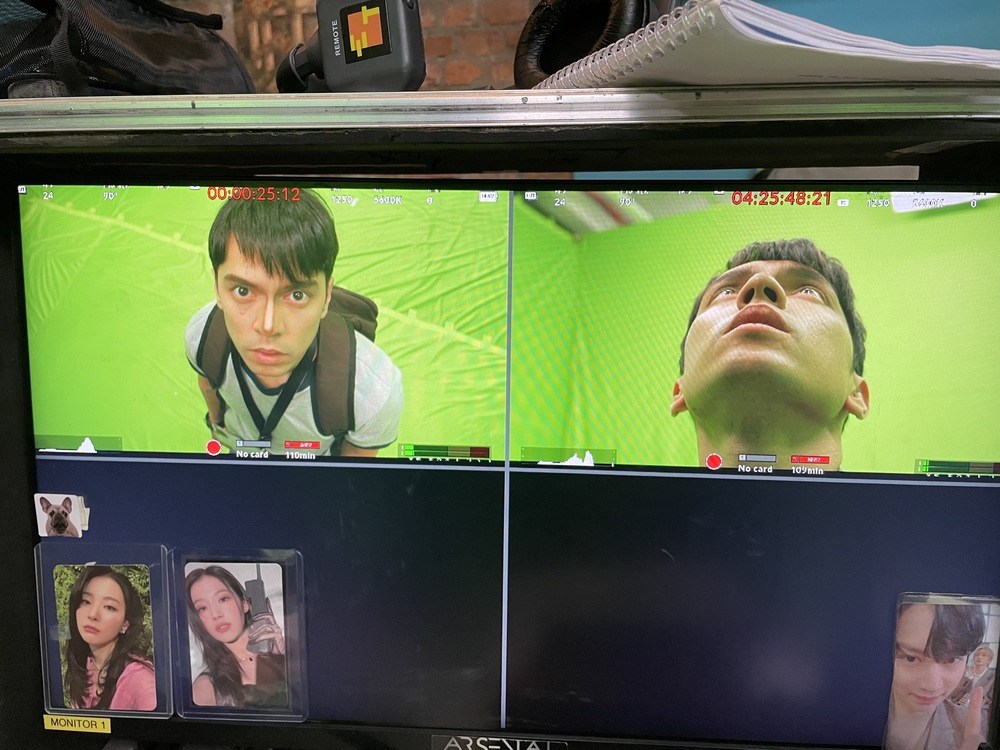 Carlo Aquino on set.
Carlo Aquino on set.
JC: That's the best thing I heard, that you didn't shoot for more than twelve hours.
C: We stuck to a specific time. And I tried to collaborate well with the actors, build rapport. If they have suggestions for the scenes, I try to think through it if it's gonna work. I remember, there is this one scene where Carlo was shooting the robots. I think [in] the first take, Gio was serious. He was shooting like "bang, bang". [laughs] In between takes...
G: Okay, you may share. [laughs] I'll allow it.
C: Between one take... Go ahead, Gio.
G: I think it was because in between takes, it was like a gag. It was a joke that Alwyn and I were making. Like there was no "bang, bang" sound in the first couple of takes. And then Alwyn and I were joking, "oh, is this how I should be shooting? BANG! BANG! BANG!" And Carl saw it and he was like "oh, I like it, we should keep that!". So that's why in the final cut of the film...
C: That was included.
G: I was making "BANG! BANG!" noises.
JC: And I think as someone who just watched it and just saw that, I thought it was such a touching detail because it was like Carlo trying to be on the same page as Eric so there is the beauty of collaboration with artists. And speaking of artists, I would want to know the artists or artworks - films or anything - that inspired you not just with this film, but in life.
C: Actually, I like the works of Richard Linklater. I'm a big, big fan. But I also am a big fan of Isao Takahata, Hayao Miyazaki, and Michael Haneke. I love their works. Gio, how about you?
G: I'm like drowning in all the different film names that you just mentioned. I was just gonna say Beyoncé and I stopped there.
C: [laughs]
G: No, I think I'm a huge fan of artists who are very good storytellers because I aspire to be in all the things that I'm doing like acting in film, acting in theater, even as a choreographer. I think stories are the heart of it all. So being an effective storyteller is important to me.
And people might think that I'm just jumping on the bandwagon and saying I love Beyoncé just because she's one of the biggest pop stars of our generation. It's not just that. She's a really good storyteller. I like that when she puts together a performance, there has to be a story. That it’s not just for show, it's not just for spectacle. So yeah, her. Barbra Streisand, that woman. Can I get any gayer?
C: [laughs]
G: But like Barbra Streisand, Lady Gaga.
C: Cher.
G: All these gay icons. They are icons for a reason. Because they're amazing storytellers and isn't that what every member of this community needs? Having successful and very effective storytellers to tell our story. So those are my favorites, the artists that I look up to.
C: I agree with Beyoncé and Lady Gaga.
JC: Not with Barbra Streisand? [laughs]
G: Barbra Streisand.
C: Well, I haven't seen that much, but I'm a fan of Funny Girl. Yeah, and A Star is Born is okay. [laughs]
G: Careful.
C: [laughs]
JC: I have also seen Funny Girl when I was 13-14 [years old]. Look what happened to me.
C: [laughs]
G: [laughs]
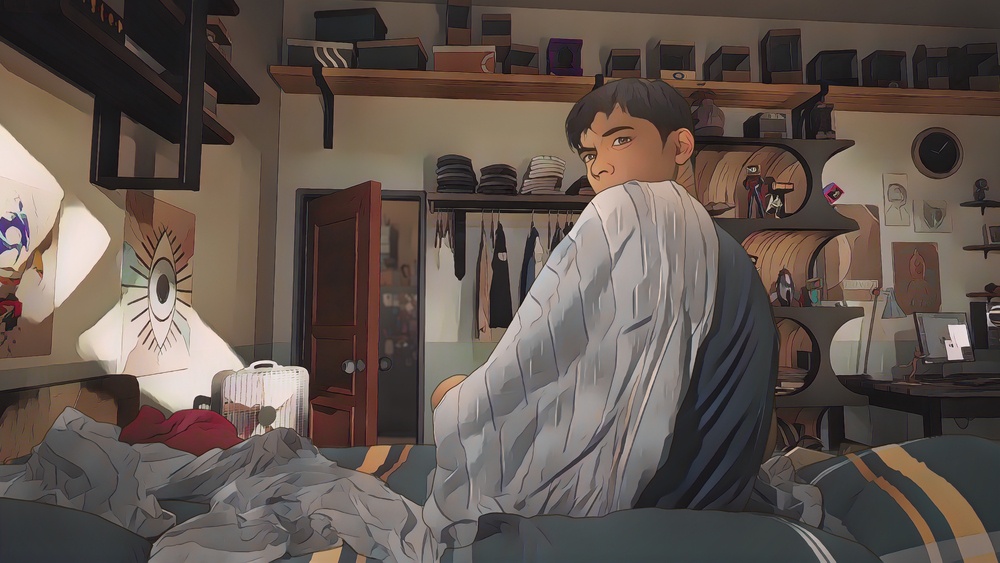 Carlo Aquino.
Carlo Aquino.
JC: I do want to ask though. This film employed 90 animators in making this film. How long was the animation process?
C: There was a part of the team that was already working [on] November 2022. So it probably took us seven to eight months to finish the whole animation because before the shoot, the animatics in the storyboard were all done. So I collaborated with the editor and the DOP to get those done ahead of time so that I have guides to send to the animators. Before shooting, the 3D designer who did the backgrounds was already doing 3D models and mockups. So around seven to nine months of animation and I think this is the longest year of my life. [laughs]
We had offline cut by the end of December last year so we had to start animating the rotoscoping parts around January. It was several months of me talking to a lot of people, checking a lot of work, and then giving them scenes to work on and then, in parallel with that, I had to talk to sound and then to music. But did I feel tired? Yeah, definitely. But it was a good feeling.
G: I wanna speak on his behalf because it's true. He really got tired. I think it's important to know this. Our animators are actually still students. So you have to understand, these kids who are amazing, by the way, have school work to do during the day. Some of them work on the frames in the middle of the night which meant Carl had to stay up in the middle of the night to check their work.
So for months, Carl and I would be chatting and he's like, he hasn't slept yet. And on top of that, he had a day job. So I don't know how he survived. He did get sick a couple of times during the eight months when they were putting together the film. But I am just happy that he's still alive. And now, he's taking good care of himself, aren't you? You should be.
C: [laughs]
JC: Stay strong, Carl. In your experience and perspective, where are we now in terms of the animation industry in the Philippines? Because we've seen, more recently, more works brought [onto] the mainstream.
C: We have a lot of animators here in the Philippines. It just so happens that we do not have a lot of content - animated films or series. Well, we have a lot of short films. The problem also is with those people who give funding to films. When they see that it's animation, it's going to be a risk right ahead because we all know it takes a lot of time to finish it. But we have a lot of great talents here in the Philippines. It just so happens that we are working on content from different countries. I think that's the problem.
The good thing is, I think it is starting. The directors and writers for original Filipino content for animation are there. We have Trese. [We have] Avid Liongoren. [They are] making animated films and series here in the Philippines. So I think we are starting to go to a place wherein we could probably create more animated films rather than now where it's just we're lucky if we get one animated feature film per year.
JC: And like in another summation, how is Philippine cinema now? Because I think for a lot of people, we're still trying to get back. We're kind of delayed in getting back into the theaters, watching movies again, especially locally-produced films. 2023 has shown much more strides in audience engagement. For the first films released in cinemas, there was a lot of hesitation. But where we are now?
C: The thing is, we keep on creating really good films. But in terms of people going back to the cinema, it's a different thing. I guess we have grown accustomed to, since the start of the streaming services, we are more prone to just watching film there or waiting for films to arrive there. The accessibility of the streaming apps and websites, I think, the Filipinos latch onto that really hard than going back to the cinema. But if there is a film that gathers the interest of the Filipinos, they go back to the cinema.
I'll just make an example. This feels like a brag. [laughs] But we did a short, two-week run of The Missing in Cinema '76. It's a micro-cinema here in the Philippines. It doesn't have a lot of seats, but more than half of the screenings are sold out. Probably because they were interested or curious to see an animated film that is going to represent the Philippines for the International Feature Film at the Academy Awards. That's our marketing for the film.
In terms of going back to the cinema, I guess it's just a matter of showing the right films. I remember [in] 2021 or 2022, they showed a remastered version of In the Mood for Love and the cinema was jampacked. I was sitting way, way back and then at the corner of the cinema. I mean, it's a niche thing. But people flocked to see that because how rare is it to see a Wong Kar-wai film on the cinema? A masterpiece. How about you, Gio?
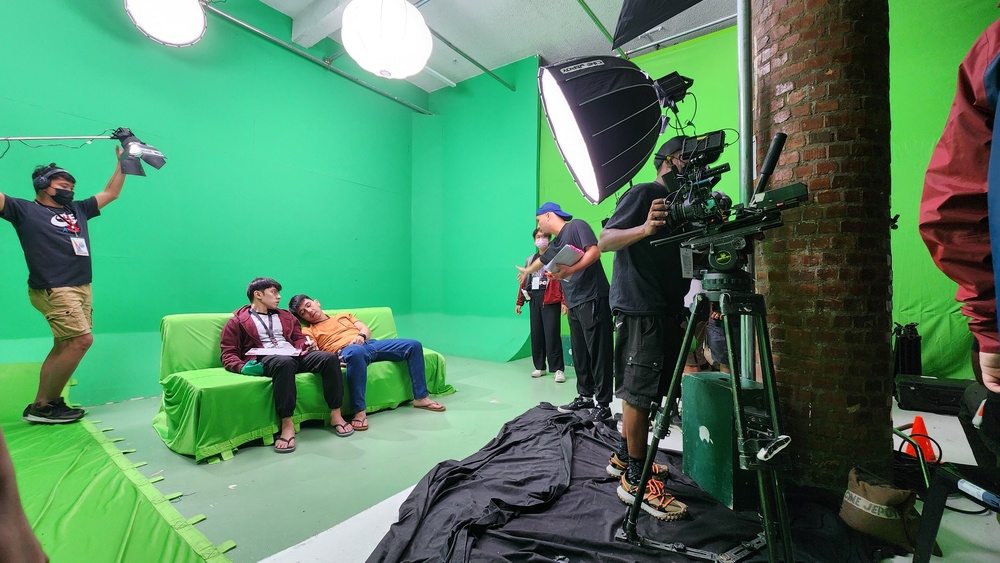 Carlo Aquino and Gio Gahol on set.
Carlo Aquino and Gio Gahol on set.
Because I think it helps a lot to go show up in Cinema '76 because there were people who, after talking to us, said "thank you, now I know what to tell my friends so I could convince them to watch". I know it's a smaller screening space, but I think that could be a start. I don't know how the filmmakers or producers could take that on. But there's nothing to be lost if we just try it because we want cinema to survive. And for things to survive, they have to be understood, they have to be learned, they have to inspire people to continue.
JC: Yeah, it takes a lot for art to not just survive but to really thrive and be alive. I would love to see where it becomes really something alive and we could sustain it. I think I've been hearing this since I was a kid "let's support Philippine films". Like, I would like for a day when filmmakers don't need to say that anymore, that it just thrives, that the environment and the situation is conducive for all kinds of artists in arts to survive. And that would entail not just funding, but distribution, exhibition, and protecting freedom of expression.
With that being said, the engagement that you guys had for the film where you were like extensions of what the film was already extending to its viewers, like you were there in the screenings. I feel like when you were making this film, you know you were making something special. But when did it hit you that the buzz [for the film] is building?
C: I guess, it's the first-ever screening at the PICC (Philippine International Convention Center). Usually, the more responsive viewers in Cinemalaya attend the gala screenings. But there was this one screening, I think it was the second day of the festival. We had our first screening in PICC and the audience was very responsive and receptive to the film. I think that was the moment that hit me that "okay, we have something here". Plus, we got the box-office thing for Cinemalaya. [laughs]
I would like to add to what you were saying a while ago. I wish that the government – or something – would force the cinemas to show one Filipino film every week. I wish we could do that. I think they do that in some countries.
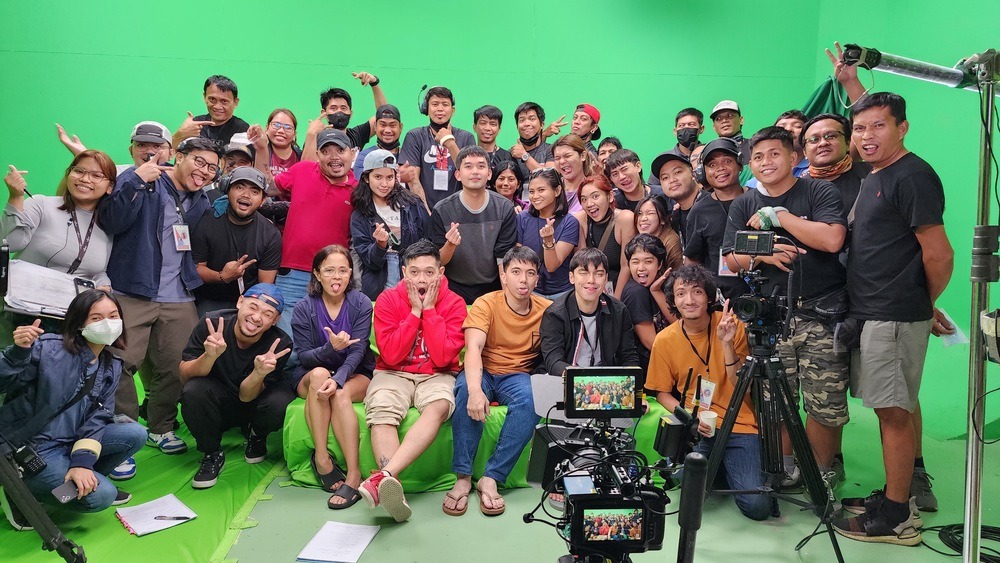 The cast and crew of The Missing on set. Centered are Dolly de Leon, Carl Joseph Papa, Gio Gahol, and Carlo Aquino.
The cast and crew of The Missing on set. Centered are Dolly de Leon, Carl Joseph Papa, Gio Gahol, and Carlo Aquino.Also, we're manifesting this: The Missing would be the third animated film to be nominated for International Feature Film. You have Waltz with Bashir (2008) and Flee (2021). Both powerful films and The Missing fits perfectly in that list of films that are using animation to tell stories that are so human. I'm really hoping that more people get to watch this.
C: We hope so too.
G: Thank you. Yes, absolutely.
C: We're trying to bring it outside of the Philippines so more screenings to come.

Here is the audio version of this interview:

Check out the official trailer for THE MISSING:
Note: The photos in this article were taken from the film's Cinemalaya page.